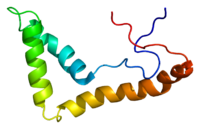
Photo from wikipedia
Background: This work aims to describe the clinico-radiological phenotype of UBTF c.628G>A (p.Glu210Lys) pathogenic variant-related neurodegeneration in childhood. Methods: We describe the progress of clinical and neuroimaging features in a… Click to show full abstract
Background: This work aims to describe the clinico-radiological phenotype of UBTF c.628G>A (p.Glu210Lys) pathogenic variant-related neurodegeneration in childhood. Methods: We describe the progress of clinical and neuroimaging features in a male individual who had childhood-onset neuroregression and carried the heterozygous UBTF c.628G>A (p.Glu210Lys) pathogenic variant. Clinical cases reported in the literature are reviewed. Results: Fifteen individuals, from 14 reported cases and the index case, were noted. The median age at onset of neurodegeneration was 3 years. Clinical phenotype was consistent among the affected individuals, with progressive motor, speech, cognitive, and social–emotional regression together with ataxia and prominent pyramidal and extrapyramidal symptoms and signs in early to middle childhood. All individuals had the same brain MRI features in terms of symmetric and diffuse T2 high signal intensity over the bilateral subcortical, periventricular, and peritrigonal white matter and progressive cortical and subcortical supratentorial atrophy. Two individuals were reported to have bilateral thalamic involvement. All individuals had profound intellectual disability with loss of verbal and/or ambulatory functions during follow-up. Conclusions: Individuals with the heterozygous UBTF c.628G>A (p.Glu210Lys) pathogenic variant had consistent clinical progress and neuroimaging features. Familiarity with this clinico-radiological phenotype may allow earlier diagnosis of this rare disease.
Journal Title: Brain Sciences
Year Published: 2022
Link to full text (if available)
Share on Social Media: Sign Up to like & get
recommendations!